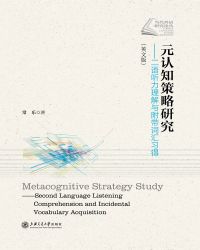6.3.2 The Relationship between Metacognitive Listening Awareness (MA) and Incidental Vocabulary Acqu
您可以在百度里搜索“元认知策略研究:二语听力理解与附带词汇习得(英文版) 艾草文学(www.321553.xyz)”查找最新章节!
6.3.2 The Relationship between Metacognitive Listening Awareness (MA) and Incidental Vocabulary Acquisition (IVA)
Research Question Four asked: What is the relationship between learners' metacognitive listening awareness and incidental vocabulary acquisition from listening tasks under the same three conditions as above in Research Question Three?
Results are presented here for the three types of vocabulary sub-tests (i. e. Form, Reception, and Production tests). The descriptive statistics for each sub-test in the two listening cycles were reported in the previous chapter. First presented in this section are the correlations between metacognitive listening awareness and each vocabulary sub-test scores in each listening cycle, and it is followed by a summary of the main findings. It should be noted that again only significant correlations are presented in this section, and the full correlation matrix of each group's metacognitive listening awareness and their vocabulary posttest scores can be found as Tables 5-12 in Appendix F. Given that the group scores for vocabulary tests differed significantly, the correlations reported below will examine the relationship between each group's metacognitive awareness scores and their vocabulary tests scores. In addition, as explained earlier, it will be necessary to report correlations for Cycle 1 and Cycle 2 separately.
6.3.2.1 The Relationship between MA and IVA (Form)
To investigate the relationship between learners' metacognitive listening awareness and their vocabulary acquisition in terms of form, the participants' metacognitive listening awareness scores and their form posttest scores were correlated. Tables 58 and 59 list the significant Pearson Product Moment Correlations obtained for Cycle 1 and Cycle 2.
In Cycle 1, for Group A (one-time listening), metacognitive awareness of planning-evaluation was negatively related with their immediate form posttest scores (r=-.298). Problem solving awareness of Group B (three-time listening) was also found to be positively correlated with the immediate form posttest scores (r=.355). For Group D (inferencing training before three-time listening), problem solving and planning-evaluation awareness were negatively correlated with their immediate form posttest scores (r=-.342; r=-.314). These correlations were statistically significant at the 0.05 level, with a 95% degree of confidence.
Also for Group D, problem solving awareness was negatively correlated with the delayed form posttest scores (r=-.434), and the correlation was statistically significant at the 0.01 level, with a 99% degree of confidence.
Table 58 Significant Pearson Correlations of the Participants' MA IVA (Form) in Cycle 1
Note. Group A=listening one time; Group B=listening three times; Group D=inferencing training+listening three times; PE=Planning-Evaluation; PS=Problem Solving; Imm=immediate posttests; Del=delayed posttests; *p<.05; **p<.01.
Table 59 Significant Pearson Correlations of the Participants'MA and IVA (Form)in Cycle 2
Note. Group A=listening one time; Group D=inferencing training+listening three times; PK=Person Knowledge; PS=Problem Solving; Imm=immediate posttests; Del=delayed posttests; *p<.05; **p<.01.
In Cycle 2, Group A's (one-time listening) person knowledge awareness was found to be negatively correlated with the delayed form test scores (r=-.395), and metacognitive awareness of problem solving was positively correlated with the immediate form posttest scores (r=.450). These correlations were statistically significant at the 0.01 level, with a 99% degree of confidence.
For Group D (inferencing training and three-time listening), problem solving awareness was found to be correlated with delayed form posttest scores (r=.321). The correlation was statistically significant at the 0.05 level, with a 95% degree of confidence.
6.3.2.2 The Relationship between MA and IVA (Reception)
To investigate the relationship between learners' metacognitive listening awareness and their vocabulary acquisition in terms of reception, the participants' metacognitive listening awareness scores and their production posttest scores were correlated. Tables 60 and 61 list the significant Pearson Product Moment Correlations obtained for Cycle 1 and Cycle 2.
Table 60 Significant Pearson Correlations of the Participants' MA and IVA (Reception)in Cycle 1
Note. Group B=listening three times; Group C=schema raising+listening three times; Group D=inferencing training+listening three times; DA=Directed Attention; MT=Mental Translation; PS=Problem Solving; Imm=immediate posttests; *p<.05; **p<.01.
In Cycle 1, directed attention metacognitive awareness was significantly correlated with the immediate reception posttest scores of both Group B (three-time listening) and Group C (schema-raising before three-time listening, r=.368; r=.366), and the correlations were statistically significant at the 0.05 level, with a 95% degree of confidence.
Mental translation was found to be negatively correlated with the immediate reception posttest scores of both Group B and Group D (inferencing training before three-time listening, r=-.400; r=-.403), and the correlations were statistically significant at the 0.01 level, with a 99% degree of confidence. Also for Group B, problem solving was positively correlated with the immediate reception posttest (r=.529), also at the 0.01 level, a 99% degree of confidence.
Table 61 Significant Pearson Correlations of the Participants'MA and IVA (Reception)in Cycle 2
Note. Group A=listening one time; Group B=listening three times; Group D=inferencing training+listening three times; DA=Directed Attention; PS=Problem Solving; PK=Person Knowledge; Imm=immediate posttests; Del=delayed posttests; *p<.05; **p<.01.
In Cycle 2, for Group A (one-time listening) directed attention was significantly correlated with the immediate reception posttest scores (r=.452). For Group B (three-time listening), problem solving was significantly correlated with the delayed reception posttest scores (r=.418). For Group D (inferencing training before three-time listening), person knowledge was significantly correlated with the delayed reception posttest scores (r=.417). These correlations were statistically significant at the 0.01 level, with a 99% degree of confidence.
Also for Group B, problem solving was significantly correlated with the immediate reception posttest scores (r=.346), and directed attention was significantly correlated with the delayed reception posttest scores (r=.354). And for Group D, problem solving was significantly correlated with the immediate reception posttest scores (r=.378). These correlations were statistically significant at the 0.05 level, with a 95% degree of confidence.
6.3.2.3 The Relationship between MA and IVA (Production)
To investigate the relationship between learners' metacognitive listening awareness and their vocabulary acquisition in terms of production, the participants' metacognitive listening awareness scores and their production posttest scores were correlated. Tables 62 and 63 list the significant Pearson Product Moment Correlations obtained for Cycle 1 and Cycle 2.
Table 62 Significant Pearson Correlations of the Participants' MA and IVA (Production)in Cycle 1
Note. Group B=listening three times; Group D=inferencing training+listening three times; PE=Planning-Evaluation; PS=Problem Solving; PK=Person Knowledge; MT=Mental Translation; Imm=immediate posttests; Del=delayed posttests; *p<.05.
In Cycle 1, the metacognitive awareness of planning-evaluation, problem solving, and person knowledge of Group B (three-time listening) were found to be significantly related to the immediate production posttest scores (r=.350; r=.366; r=.336). For Group D (inferencing training before three-time listening), mental translation awareness was also found to be negatively correlated with the delayed production posttest (r=-.391). These correlations were statistically significant at the 0.05 level, with a 95% degree of confidence.
Table 63 Significant Pearson Correlation of the Participants'MA and IVA (Production)in Cycle 2
Note. Group B=listening three times; PE=Planning-Evaluation; Imm=immediate posttests; *p<.05.
In Cycle 2, only the metacognitive awareness of planning-evaluation of Group B (three-time listening) was significantly correlated with immediate production posttest scores (r=.377). The correlation was significant at the 0.05 level, with a 95% degree of confidence.
6.3.2.4 Summary of the Main Results of the Relationship between Learners' Metacognitive Awareness and Incidental Vocabulary Acquisition
(a) For Group A (one-time listening), negative correlations were found between the awareness of planning-evaluation strategies and immediate form test scores in Cycle 1 and between the awareness of person knowledge strategies and delayed form test scores in Cycle 2. Also in Cycle 2, positive correlations were found between the awareness of directed attention strategies and immediate reception test scores in Cycle 1 and between the awareness of person knowledge strategies and immediate form test scores.
(b) For Group B (three-time listening), there was a consistent and positive correlation between the reported use of problem solving strategies and the immediate reception test scores in both cycles, and alsobetween planning evaluation strategies and immediate production test scores in both cycles. For this group, there are positive correlations between the reported use of directed attention strategies and scores in the immediate reception test in Cycle 1 and scores in the delayed reception test in Cycle 2. And there are also positive correlations between the reported use of problem solving strategies and the immediate form test and production test scores in Cycle 1 and the delayed reception test scores in Cycle 2. Besides, in Cycle 1, a positive correlation was found between the awareness of person knowledge strategies and immediate production test scores and negative correlation was found between the awareness of mental translation strategies and immediate reception test scores.
(c) For Group C (schema-raising training before three-time listening), the only significant correlation evident was between the reported use of directed attention strategies and the immediate reception test scores in Cycle 1.
(d) For Group D (inferencing training before three-time listening), negative correlations were found between the awareness of problem solving strategies and both immediate and delayed form test scores in Cycle 1, but positive correlations were found between this awareness and delayed form test and immediate reception test scores in Cycle 2. Also in Cycle 1, negative correlations were found between the awareness of mental translation strategies and immediate reception test and delayed production test scores, as well as between the awareness of planning-evaluation strategies and scores in the immediate form test. Also in Cycle 2, a positive correlation was found betweenthe awareness of person knowledge strategies and delayed reception test scores. 元认知策略研究:二语听力理解与附带词汇习得(英文版)

